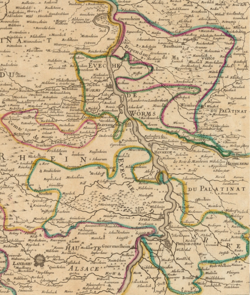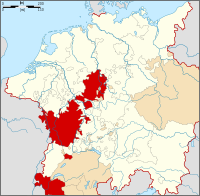Prince-Bishopric of Worms
This article relies largely or entirely on a single source. (December 2009) |
Prince-Bishopric of Worms | |||||||||
|---|---|---|---|---|---|---|---|---|---|
| 861–1802 | |||||||||
 The Prince-Bishopric of Worms circa 1700 | |||||||||
| Status | Prince-Bishopric | ||||||||
| Capital | Worms until 1400; thereafter Ladenburg | ||||||||
| Common languages | Ripuarian Franconian | ||||||||
| Government | Prince-Bishopric | ||||||||
| Historical era | Middle Ages | ||||||||
• Bishopric founded | 614 | ||||||||
• Gained Reichsfreiheit | 861 | ||||||||
| 1795 | |||||||||
| 1802 | |||||||||
| |||||||||

The Prince-Bishopric of Worms was an ecclesiastical principality of the Holy Roman Empire. Located on both banks of the Rhine around Worms just north of the union of that river with the Neckar, it was largely surrounded by the Electorate of the Palatinate. Worms had been the seat of a bishop from Roman times. From the High Middle Ages on, the prince-bishops' secular jurisdiction no longer included the city of Worms, which was an Imperial Free City (the Free Imperial City of Worms) and which became officially Protestant during the Reformation. The prince-bishops however retained jurisdiction over the Cathedral of Worms inside the city.
In 1795 Worms itself, as well as the entire territory of the prince-bishopric on the left bank of the Rhine, was occupied and annexed by France. In the wake of the territorial reorganizations that came with the German mediatization of 1802, the remaining territory of the bishopric, along with that of nearly all the other ecclesiastical principalities, was secularized. In this case, it was annexed by Hesse-Darmstadt.
Bishops of Worms, 770—1802
[edit]
|
|
|
References
[edit]- ^ Gams, Pius Bonifacius (1873). Series Episcoporum Ecclesiae Catholicae. Graz Akademische Druck- u. Verlagsanstalt. pp. Vol. 1 323-324.
External links
[edit] Media related to Bishopric of Worms at Wikimedia Commons
Media related to Bishopric of Worms at Wikimedia Commons
- Prince-bishoprics of the Holy Roman Empire in Germany
- Worms, Germany
- Catholic League (German)
- Upper Rhenish Circle
- Dioceses established in the 9th century
- Former Roman Catholic dioceses in Germany
- States and territories established in the 860s
- States and territories disestablished in 1802
- 861 establishments
- 9th-century establishments in Germany
- 1802 disestablishments in the Holy Roman Empire
- Former countries
- Former monarchies of Europe



